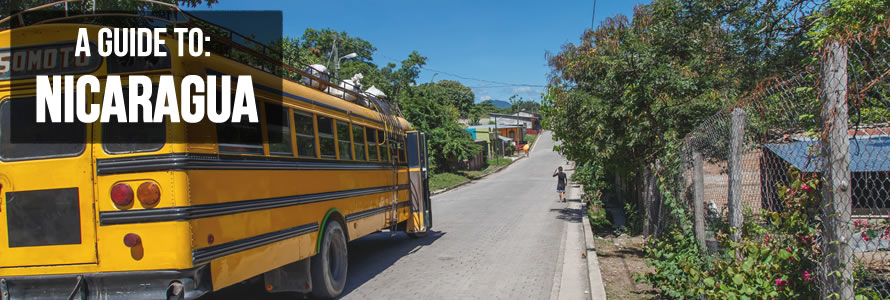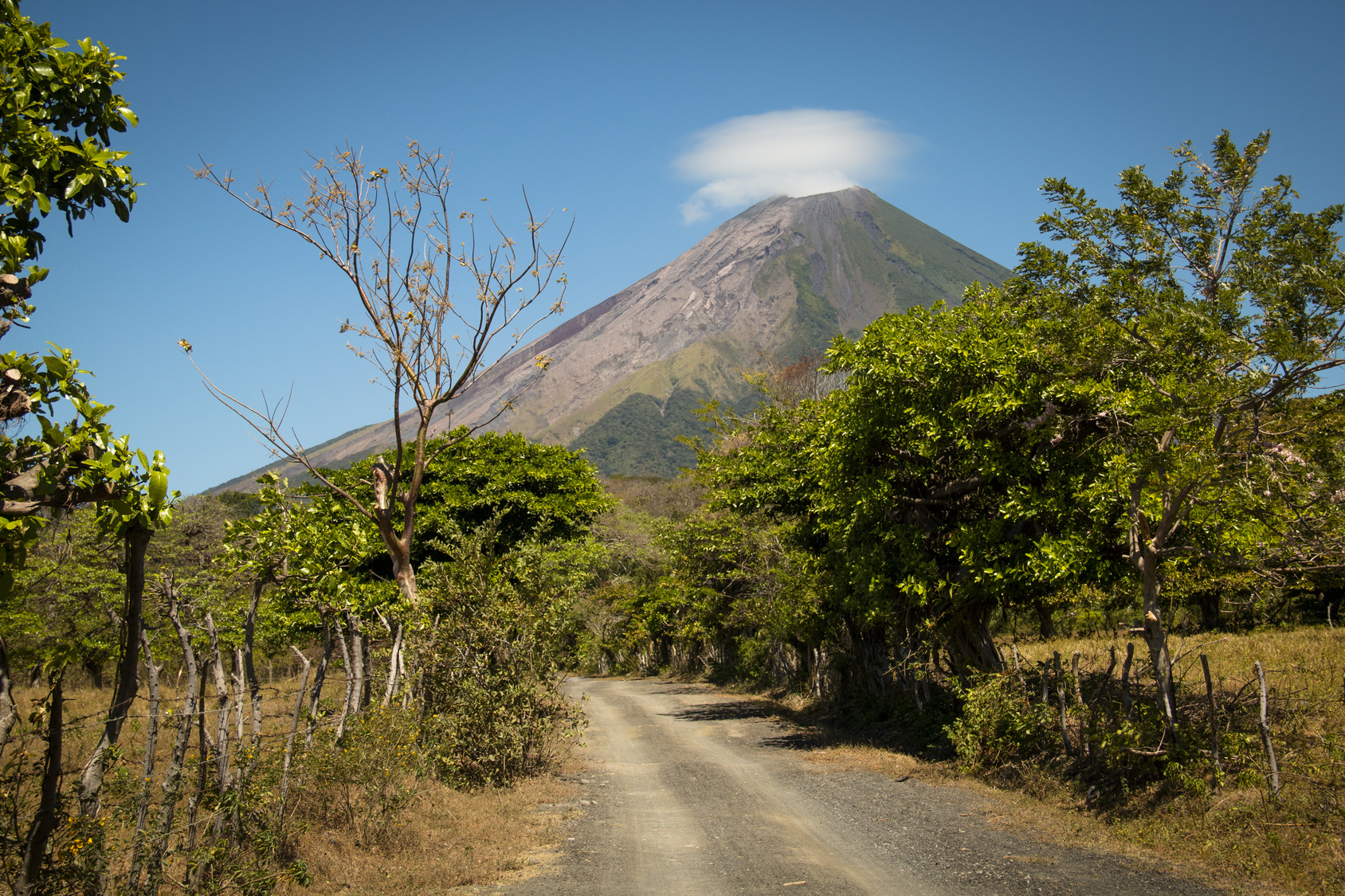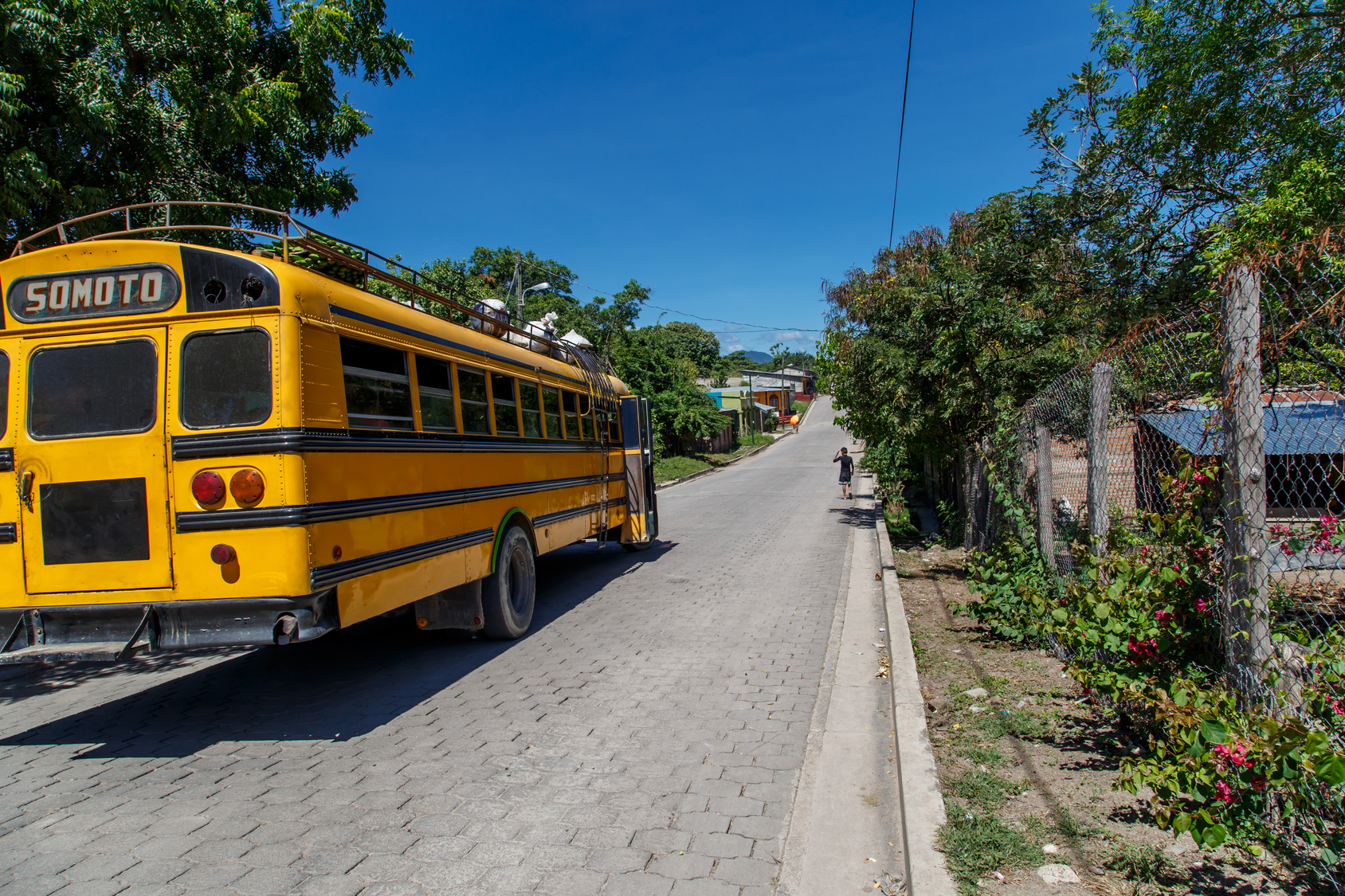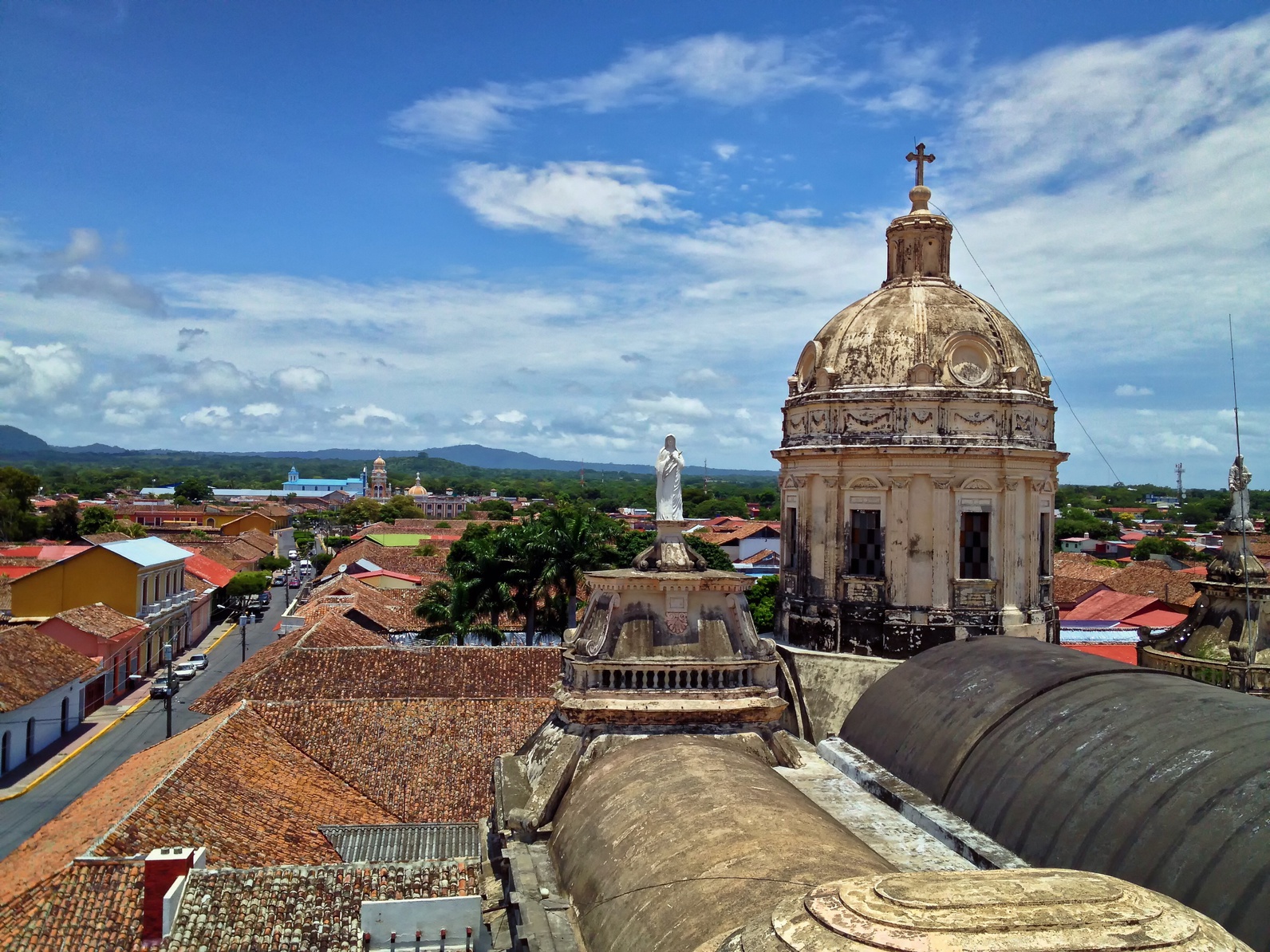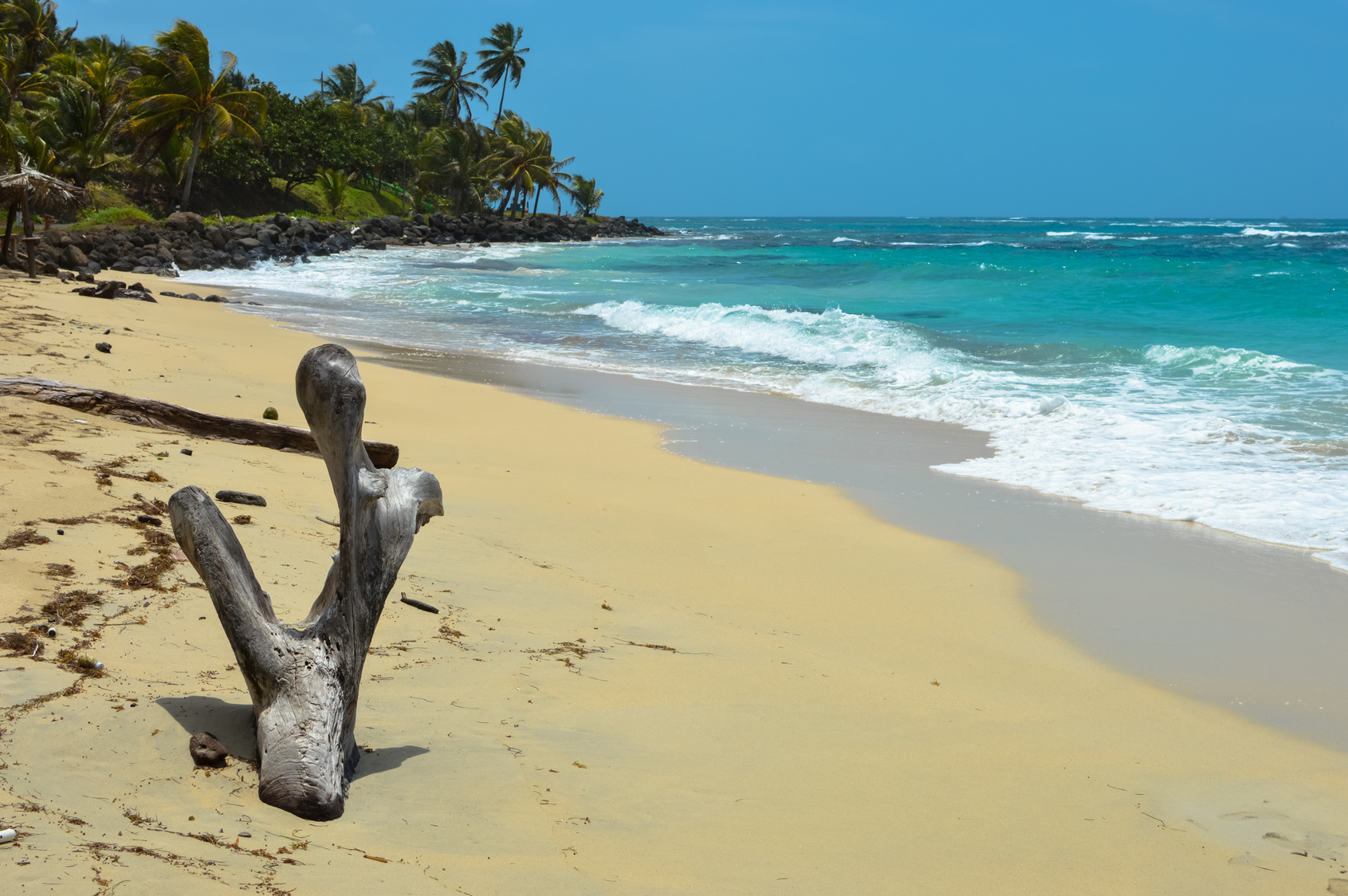A bit of a late comer to the backpackers’ Latin American circuit, Nicaragua is both Central America’s largest and poorest country. As new-kid-on-the-block it lacks some of the slick and well-established tourist infrastructure of other Central America destinations but it is this very fact – along with it being a budget-friendly destination – which acts as a magnet for travellers and, increasingly, holiday makers, especially from the US.
Nicaragua has heaps going for it – for starters it has two coastlines, both the surf-rich wave-riding playground of the Pacific and the colourful, reggae-flavoured Caribbean coast while a little off this coast sit the stunning tropical paradises of the Corn Islands. The country is also home to Central America’s largest freshwater lake (which also happens to in turn be home to a rare sub-species of bull shark which swims up the river from the ocean…and we’re not kidding) – the beautiful Lake Nicaragua which is awash with stunning islets and the twin volcano peaked travellers’ tranquil escape island of Ometepe.
Besides those on Ometepe, Nicaragua has volcanoes by the score – many very much active and continually spewing forth billows of smoke – that act as playgrounds for all kinds of fun stuff including hiking, rainforest canopy zip-lining, wildlife spotting jungle safaris, lava viewing tours and volcano boarding. History is rich here and Nicaragua’s colourful story weaves in chapters of invading conquistadors, marauding pirates and bloody revolutions. The colonial splendours left behind by the Spaniards are best showcased in lovely Granada and atmospheric Leon while nature lovers may be pleased to learn that Nicaragua is home to the largest rainforest north of the Amazon. Nicaragua is still up-and-coming, much underrated and still in the main uncrowded – get in quick before everyone wakes up to what it has to offer.
Visas
Citizens from a huge number of countries can enter Nicaragua either without a visa or can obtain a visa on arrival. The visa duration for most is 90 days but you need to be aware of an inter-country agreement if you are also intending to travel to Guatemala, Honduras or El Salvador too. These three countries along with Nicaragua have a free movement across borders visa collaboration known as CA-4. Any visa you are awarded applies to all of those countries so if you have 90 days this means you have 90 days in total for the four countries not in each.
Weather
Quite what the climate is going to serve up during your Nicaraguan visit will very much depend on where you are and what time of year it is. If you hit Managua, Leon or Granada you can expect to have not just high temperatures – especially in the dry season – but energy-zapping high humidity which offers little in the way of relief even at night. If you head into the higher latitude areas – typically those in the north around the Matagalpa region – you can expect much cooler climes which might even necessitate an extra layer or two of clothing at times. Rainy season hits around May and lasts until October. Rainy season doesn’t mean it rains all the time and there is still plenty of sun but when it does rain it can be torrential and is often thunderstorm accompanied. Rains tend to cool everything down and in places which are already cooler this can feel downright chilly.
How Safe is Nicaragua?
A political war was still raging in Nicaragua in the 1980s and although the country is today politically stable the reputation of those earlier times seems to inexplicably linger on. It is not uncommon to hear people talking about Nicaragua as an unsafe country but the fact is it ranks relatively highly on the Global Peace Index. Nicaragua ranks as 69th while the UK is 47th and the USA way behind at 103rd which perhaps puts it into some measurable perspective. Generally speaking, Nicaragua is a safe destination even for females travelling alone.
Like anywhere in the world, some places require you to be a little more on your guard than others while some are best avoided all together. Cities after dark are particular hot-spots for problems especially if you are showing obvious signs of being drunk or are carrying a bag which makes you a target. If in doubt, grab a taxi, even for the shortest journeys – they are mega cheap – and be sure to listen to any local advice you are given.
Accommodation
Although it is a more recent destination addition to the travellers’ map than many of its Central and South American counterparts, Nicaragua still offers a huge variety of accommodation options particularly in the budget and backpacker price bracket. Hostels and cheap guest-houses are everywhere and typically of a good standard and among the cheapest you’ll find anywhere in Latin America.
Food
Nicaragua is not really a destination for the food passionate. There are some local specialities but generally speaking the country lacks any distinguished or notable cuisine or particular flavours of its own. That doesn’t mean you can’t get great food if you look it just means that ‘typically Nicaraguan’ is unlikely to delight and surprise in the way – say for example – Mexican food would.
Cheap eats are everywhere and although the culture is less street food focused than many – in Granada this is a barely known concept at all unless you count hot-dog stands and quesadillas – local comedors dish up hearty meals for rock bottom prices. These no-frill places are where the locals eat and generally involve rice or gallo pinto – the rice and beans staple of the country – along with choices of meat dishes, salad sides and vegetables.
The other cheap way to eat is the ‘plato del dia’ (literally plate of the day’) offered at tourist and local restaurants alike. Western/European food is widely available in the more tourist-centred cities and destinations but, as is usually the case, is more expensive than local fare. Hostels without a guest kitchen for preparing your own meals are rare and as local markets sell cheap-as-it-comes raw foods, many find this is the cheapest option of all for meals.
Language
Spanish is Nicaragua’s official language and while you’ll find pockets of English speakers – in San Juan del Sur especially – don’t expect this to be widespread, even in tourist restaurants, bars and cafes. As with anywhere, a little mastery of the local lingo will alter and enhance any experiences you have considerably and make it far easier to both get around and communicate basic needs. There are many who travel her with zero Spanish speaking skills and seem to get by. The choice is yours.
Getting Around the Country
The cheapest means of getting from A to B for both longer and shorter distances in Nicaragua is by chicken bus and these vehicles have a countrywide network which is extensive, frequent and surprisingly on time. These often highly colourful old converted US school buses can be a real experience but they can also be an endurance exercise when the tropical heat is blazing, things get crowded and they seem to stop every 50 metres or so to pick up more passengers.
There are also heaps of tourist buses and shuttles which link all the major tourist hot spots such as Granada, Leon, San Juan del Sur, Ometepe departure points and Matagalpa. Additionally, if you are looking to get across borders you can take advantage of the slick Tica bus service which crosses every border in Central America. Not only is this the fastest way to make these journeys but also removes much of the hassle typically involved with border crossings. In some cases you don’t even have to get off the bus. In the cities taxis are everywhere and outside of Managua typically very cheap. Meters are not common so be sure to agree on your fare before setting out anywhere.
Nicaragua Highlights – Things to See & Do
The Volcanoes
If you’re interested in volcanoes you’ve come to the right place. Nicaragua has a whole bunch of them, strung in a line which stretches from top to bottom on the country’s western side. Many of them are very much active or very recently erupted and both these and the dormant ones offer a variety of experiences for the Nicaraguan traveller. These include night lava tours, hiking, nature discovery, crater lake swimming, volcano boarding and typically views of the breath-taking kind.San Cristobal – This soaring super-active giant is Nicaragua’s highest volcano and with its almost perfect cone shape and constant emissions of smoke it represents everyone’s iconic idea of what a volcano should look like. Hikes to the top are possible but as this climb is as about as difficult as it gets in Nicaragua is not for the trekking newbie.Mombacho – Possibly the country’s most well-known volcano due to its close proximity to Granada and the tourist infrastructure here which makes it easily accessible. The fertile slopes of dormant volcanoes are often densely vegetation covered and beautiful Mombacho is no exception. This volcano’s biggest draw aside from its spectacular views are its tropical jungle covered slopes and cloud forest summit which support a diverse eco-system of flora and fauna including monkeys and countless birds. Wildlife experiences, rewarding hikes, canopy zip-lining and coffee finca tours are all possible here.
Masaya – Situated halfway between Managua and Granada, Masaya is – along with Mombacho – one of the most accessible volcanoes in Nicaragua and allows even the most physically unfit to get to the top by way of trucks which drive the paved road to the top. This volcano emits a constant huge cloud of steam and smoke and during frequent periods of heightened activity night tours are conducted to see the lava in the crater. The views at anytime are wonderful and it is also possible to see the resident colony of parakeets or visit bat-filled caves – actually lava ‘tubes’ formed during past eruptions.
Concepción and Maderas – These two volcanoes – the former active and the latter dormant – form the two halves of the Nicaragua Lake located island of Ometepe. Smoke-, ash- and gas-spewing conically-shaped Concepción is a towering monster, not far short in height from the mighty San Cristobal, while Maderas’s slopes are richly tropical vegetation covered and home to a beautiful crater lake. Hikes are popular on both volcanoes; hiking Concepción is a challenging but highly rewarding 10 hour experience through banana and coffee plantations while Maderas is less steep but still a long slog.
Cerro Negro – As a young and very active volcano, the slopes of Cerro Negro are a blackened scene of rocks, ash and volcanic sand totally bereft of vegetation. Although this landscape is bleak it has a beauty all its own although far removed from the lush greenery-clad Maderas and Mombacho. However, people don’t really come here to bask in its loveliness but rather to whizz at breakneck speeds down the volcano’s side with a spot of volcano boarding. Just in case you’re interested – the record speed for descent in this way is 95kmh.
Granada
Simply put Granada is lovely. Sitting on the edge of vast Lake Nicaragua, this city was once one of the brightest jewels in the Spanish colonial crown and today much of its treasure has been well-preserved for all to see in the colourful historical centre. Museums, galleries, grand colonial houses and structures, a great number of churches both of the scrubbed and quietly crumbling variety – including La Merced which has a bell tower to be climbed for stunning views – and buildings painted in every colour – this is what Granada is made of.The pretty tree-dotted main plaza is looked over by the ochre, terracotta and white decorated cathedral while the buzzing greenery-lined pedestrian street full of bars and restaurants known as the Calzada leads from here down to the lake.The lake is strewn with many islets and kayaking around these – particularly at sunset – is a popular tourist activity.
Leon
Colonial Leon is Granada’s less polished cousin, rivalling it for the number of historically significant buildings and structures and outdoing it by way of churches and cathedrals by a considerable way. While some would describe Leon as scruffy, others prefer its earthier and more authentic air over super-shiny Granada. Nicaragua’s biggest city after the capital, Leon was once the country’s capital and a huge number of politically-themed murals and graffiti cover the walls around this city serving as reminders that not so long ago a war raged here between the Sandinistas and the Somozas; if this aspect of the country’s history interests you a visit to the Museum of the Revolution is a must. Nearby are Poneloya beach and the volcanoes of Momotombo and Cerro Negro.
Ometepe
Essentially formed by two linked volcanoes – Concepción and Maderas – this Lake Nicaragua located island is a tranquil oasis beloved by the nature passionate and those looking to escape the city. People come here to hike the volcanoes, kayak the calm surrounding waters, swim, motorbike or cycle around or generally just laze about for a few days using one of the several hostels or guest-houses as a base.
Laguna de Apoyo
Lovely in the extreme, many come to this peaceful crater lake spot as a day trip from nearby Granada. Besides some hikes around the top and among the lush tropical greenery there’s not much to do here besides swim in the crystal clear waters and lounge around drinking in the stunning scenery but that’s kind of the whole point. There is a public beach but most opt for a cheap, few dollar day pass at one of the beautiful terraced hostels here. This gives you private access to lovelier beaches, the chance to eat and drink when the mood hits and free use of kayaks, stand-up paddle boards and inflatable inner tubes for some meditative effortless drifting on the lake. If you are truly looking for some serenity time opt to stay overnight at one of the hostels and experience some true hush and nature immersion once the day-trippers head for home late afternoon.
The Corn Islands
If you’re looking for a slice of tropical idyll head to Nicaragua’s Corn Islands. These easy-to-access islands are truly Caribbean flavoured – both literally and metaphorically speaking – and very different to what you will experience in Nicaragua’s Pacific coast destinations or inland. Life is very laid back here and as chill out destinations in the country go it probably gets no better than this. Scuba diving, snorkelling, fishing and generally topping up the tan on white-sand/turquoise sea lapped beaches are what most people do here.
Rio San Juan
Give it a few years and this beautiful rain forest area – the biggest you’ll find on the continent north of the Amazon – will almost certainly have a more developed tourist infrastructure in place as travellers wake up more and more to what it has to offer in the way of nature immersion and biodiversity. For now though things here are super low key and should you venture into its rewarding environment you will have to share it with few other visitors. Low key doesn’t mean there is nothing to do though – fishing, kayaking, hiking, bird-watching, horse-riding and wildlife safaris are all on the menu.
The Beaches (and learning to surf)
Nicaragua has plenty of places offering the same quality surf as Costa Rica but here things are far less expensive and far less crowded. That makes it a great place to learn to surf and that is exactly what many do who come here. Surf beaches are strung out all along the Pacific coast and range from the busy and buzzing to the tucked away and tranquil. Choose your vibe and spot, sign up with one of the many surf instructors offering their services and be up and riding the waves before you know it.Nicaragua is not especially lauded for its beaches and although some are truly lovely there are some also which are truly mediocre so if you want some beach time choose carefully. If you’re looking to party, backpacker central is San Juan del Sur which has grown into a sprawling mass of cheap bars, hostels by the bucket-load and a hundred and one places for after-dark fun.
Wildlife
Wildlife in Nicaragua is neither as obvious nor plentiful as it is in Costa Rica but if you are intent on having some nature experiences it is nevertheless there for the taking although you will have to make some effort. Besides the ubiquitous geckos and iguanas which can be found even in cities, the native fauna is somewhat more tucked away in Nicaragua. What can be found living in pockets of jungle and other environments are such things as sloths, monkeys, jaguars, armadillos, anteaters, turtles and a host of exotic bird-life which includes everything from pelicans to parakeets.

